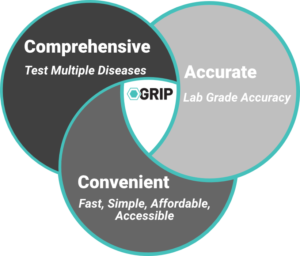We’re excited to share that our innovative graphene biosensor assays are on track for a 2027 release, set to transform home-based infectious disease testing as mentioned in a recent article by 360Dx covering emerging economic and technological trends in the clinical diagnostic market.

360Dx: Grip Molecular Aims for 2027 Launch of Home-Use Graphene Biosensor Assays
Testing startup Grip Molecular aims to shake up the market for home-based infectious disease tests with its biosensor-based cartridges that can measure for molecular targets or proteins in minutes using only a swab sample and a jolt of energy from a wireless charging-enabled cell phone.
Jan 31, 2024 | Greg Cima
NEW YORK – Testing startup Grip Molecular aims to shake up the market for home-based infectious disease tests with its biosensor-based cartridges that can measure for molecular targets or proteins in minutes using only a swab sample and a jolt of energy from a wireless charging-enabled cell phone.
Late last year, Grip wrapped up its first clinical feasibility study for its COVID-19 test in a collaboration with Vancouver, Washington-based Molecular Testing Labs, saying its partners found that Grip’s test results correlated with PCR results with 90 percent accuracy.
Bruce Batten, Grip’s founder and CSO, said those results support Grip’s findings from previous internal studies that its saliva-based test for the SARS-CoV-2 virus spike protein can offer accurate results with sensitivity comparable to that of commercial labs and point-of-care tests. The firm hopes to make its market debut in 2027 with its multiplex syndromic test to differentiate COVID-19, flu A/B, and respiratory syncytial virus, as well as common cold viruses.
Company officials have previously said they anticipate adding biomarkers for more sources of respiratory infections, streptococcus, and sepsis.
Each of Grip’s single-use hexagonal cartridges is about the same size and weight of a poker chip. They employ an array of graphene field-effect transistor (GFET) biosensors that can be used to detect up to 32 analytes or pathogens in a multiplex test, with the results delivered within five minutes.
Like many other point-of-care COVID-19 tests, Grip’s assay begins with a swab sample that is swirled in buffer, with the mixture added to the cartridge. The user next holds the cartridge next to their phone while the assay runs and the cartridge draws a miniscule amount of power through wireless charging, Batten said.
The cartridges also use near-field communication to transfer the results to an app that can be used to read the results and share them with a healthcare provider.
Inside the cartridge, a fluidic channel delivers the sample to an array of graphene biosensors, where changes in the electric field are used to draw the target toward capture molecules and adhere the target to the surface. The electrical signal from that sensor changes as targets are captured. Batten said the firm’s studies indicate its COVID-19 test has a limit of detection of 5,000 copies/mL.
Grip CEO Edward Gillen said that the capture molecules used in each assay are applied to the test’s sensor surface using an inkjet-style printing process. Switching over production to a new assay is as easy as swapping out the biological agents in the printer or adding new probes to the existing array
Boston-based GrapheneDx has similarly said it is developing 5 minute tests for use in homes and at the point-of-care using its own GFET technology and antibodies. Last year, the firm struck a manufacturing and commercialization deal with Sapphiros and General Graphene starting with sexually transmitted infection tests.
Competitors
Meanwhile, Qorvo Biotechnologies, a subsidiary of semiconductor company Qorvo, brought a COVID-19 test to market and had been developing into 2023 a pipeline of bio-sensor tests using its bulk acoustic wave Omnia instrument. However, veterinary health firm Zomedica bought the subsidiary in the fall and said it plans to focus its resources on the development of veterinary products.
Academic researchers, too, have been moving the field forward with study results that could aid develpor of new types of biosensor tests or improve methods of identifying targets on biosensors.
Developing tests for the home-use market can present its own challenges due to the lack of payor reimbursement, yet some industry watchers are optimistic that the increasing comfort among consumers with self-testing and the desire to become involved in one’s healthcare will translate into opportunities for test makers to thrive.
While fledgling companies that bet big on COVID-19 testing have struggled as testing has dropped off, Gillen said Grip’s market research showed a pre-pandemic trend in favor of at-home testing and continues to support the firm’s business plan.
“The underlying trend toward home-based diagnostics and a desire for it is still there,” he said. “And, so, our intent is to basically progress the company to produce the products and solutions that people want.”
Gillen said the St. Paul, Minnesota-based firm aims to sell the tests through retail pharmacies and to market them to household caregivers who buy cold and flu remedies. He said market research indicates those caregivers are primarily women, who disproportionately care for children younger than 7 years old and elderly relatives.
“We’re designing this, basically, for moms as the primary consumer of the types of diagnostic tests that we think are in the areas of greatest need,” he said, adding those consumers also want to couple the test results with a telehealth appointment rather than wait until their pediatrician’s office reopens.
With an anticipated cost of goods below $10 per panel, he thinks the company could offer its respiratory assays in stores for about $40 per panel.
“We will be relying on our retail pharmacy partners to help us to promote the product and to do the discounting and the advertising at the point-of-sale,” Gillen said.
Women are also the prime audience for the firm’s multiplex urinary tract infection test that is under development, Gillen said. The firm is in the process of creating that test for use with a urine sample.
Grip is also eyeing development of tests for sexually transmitted infections, and Batten noted that those tests could complement UTI tests because they can cause similar symptoms.
Grip’s researchers have determined that the company’s tests can be used to differentiate bacteria strains with antimicrobial resistance, and that information could help healthcare providers combat the high rates of recurrent UTIs, Gillen said. Clinical guidelines indicate 20-40 percent of women have had recurrent UTIs.
“We can provide the clinician with specific information about which antimicrobial resistance we detected, and, so, the doctor would know to avoid those antibiotics because the likelihood of them working is probably not very high,” he said.
Company scientists have previously shown that the biosensors and probes that are incorporated into Grip’s cartridges could be used to detect various types of targets.
Grip scientist Narendra Kumar reported in 2020, when he was a physics researcher at Boston College, that he and fellow researchers from Boston College and Boston University achieved species-specific detection in five minutes of bacterial strains through dielectrophoresis-based capture of the targets with synthetic peptides on a graphene field-effect transistor. The research results published in Biosensors and Bioelectronics were confirmed by microscopy.
Kumar was also the lead author of a report published that same year in the preprint server BioRxiv in which he and his coauthors used GFETs coupled with RNA aptamers to detect in saliva the presence of the enzyme carbonic anhydrase 1, which has been identified as a potential marker of conditions including cancers, diabetes, and pancreatitis. And, in 2022, Kumar was the lead author of an article on the use of the GFET-based technology, published in ACS Nano, on the simultaneous detection of three opioid metabolites in wastewater samples.
Batten said that the research at Boston College led to the development of probes specific to antimicrobial resistant bacteria and included probes that could be used to differentiate drug-resistant strains of Escherichia coli from drug-susceptible ones. The firm plans to put those drug resistance detection probes to use in its assays for bacterial infections, although further development of capture probes is needed, he said.
Pivot to COVID
At the time of Grip’s founding in 2019, the firm was focused on flaviviruses such as Zika, dengue, and chikungunya. Batten said he saw the potential to develop assays that could help address serious healthcare needs in parts of South America and Asia. That work has been on the back burner since the SARS-CoV-2 virus emerged.
“Soon after I founded the company, the pandemic hit, so we had an obligation to then pivot to upper respiratory if we could provide a solution that could be used in the home to help people monitor their health and prevent the spread of the disease, as well,” he said.
Grip hopes to submit its upper respiratory infection panel to the US Food and Drug Administration for 510(k) clearance by late 2026 and launch that test in 2027. The firm previously announced plans to seek CE marking or In Vitro Diagnostic Regulation approval to sell the tests in Europe. The timeline for developing assays further along in the company’s pipeline will depend on fundraising, Batten said.
The firm announced in 2021 that it had raised the funds to complete its proof-of-concept experiments, gain exclusive rights to the IP behind the tests, open its research facility, and recruit a management team. The firm said in investor presentation documents that a seed round is underway, and it anticipates the launch of a Series A funding round to raise about $12 million to fund product development.
Because the test probes can be designed to capture antigens, antibodies, enzymes, hormones, peptides, and even small molecules such as glucose, Batten sees long-term potential for the tech to be developed into broad applications, including cardiac health, kidney function, concussion evaluation, fertility, and inflammation monitoring.
“It’s a platform that could be used for just as many different applications as you can imagine,” he said.










